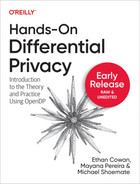Many organizations today analyze and share large, sensitive datasets about individuals. Whether these datasets cover healthcare details, financial records, or exam scores, it's become more difficult for organizations to protect an individual's information through deidentification, anonymization, and other traditional statistical disclosure limitation techniques. This practical book explains how differential privacy (DP) can help. Authors Ethan Cowan, Mayana Pereira, and Michael Shoemate explain how these techniques enable data scientists, researchers, and programmers to run statistical analyses that hide the contribution of any single individual. You'll dive into basic DP concepts and understand how to use open source tools to create differentially private statistics, explore how to assess the utility/privacy trade-offs, and learn how to integrate differential privacy into workflows. With this book, you'll learn:
Table of Contents
- 1. History
- 2. Privacy in the Classroom
- 3. Differential Privacy Fundamentals
- 4. Dataset Transformations, Dataset Distance, and Stability
- 5. Event-level Data and Differential Privacy
- 6. A System for Relating Distances
- 7. Machine Learning and Differential Privacy
- 8. Machine Learning Part II
- 9. Defining Privacy Loss Parameters of a Data Release: How to Choose Epsilon, Delta and Other Greek Letters
- 10. Protecting Your Data Against Privacy Attacks
- 11. Differentially Private Synthetic Data
